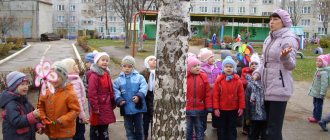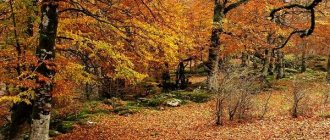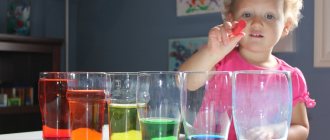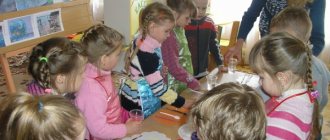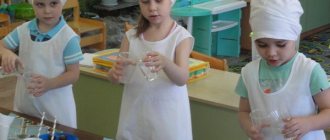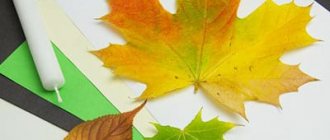Theoretical aspects of conducting observations in the middle group of preschool educational institutions
Observation is the purposeful perception by preschoolers of objects and environmental phenomena, specially organized by the teacher. This process is quite complex, since it simultaneously involves sensory perception, mental processes (the ability to analyze, draw conclusions, find cause-and-effect relationships) and the child’s speech. In addition, the child’s existing knowledge and experience are important for successful work.
Such activities become an important component for the formation of a preschooler’s ecological culture, since they are aimed at the following results:
- The children have a desire to communicate more with nature, while reflecting their impressions in productive activities and various games.
- A correct understanding of the essence of natural phenomena and a caring attitude towards plants and animals is established.
- Children acquire practical knowledge about nature conservation.
A 4-5 year old child perceives the world around him through images and emotions, so competently organized observation is a source of varied and memorable impressions for pupils.
Tasks
At the secondary preschool level, observations solve the following tasks:
- Deepening knowledge about seasonal changes in nature: kids learn to notice and name phenomena such as wind, leaf fall, snowfall, etc., identify signs of a specific time of year, compare landscapes in different seasons (autumn and winter, winter and spring, etc. ).
- Forming the ability to establish elementary connections between natural phenomena (for example, it got cold - insects disappeared, plants faded, it froze - water turned into ice).
- Expanding understanding of the diversity of plants and animals, birds and insects, their condition and behavior at different times of the year.
- Deepening knowledge about the properties of inanimate objects (for example, water and sand, stones and clay, etc.).
- Development of ideas about the work carried out in the kindergarten area (janitor’s work in different seasons), in the flower garden, vegetable garden (planting seeds, caring for plants, harvesting).
- Clarification of ideas about objects of the social world (how passers-by are dressed in a certain season, consideration of transport, pedestrian crossings, traffic lights, etc.).
Working methods
Children of the fifth year of life already have certain ideas about nature, they are capable of detailed perception of objects. Nevertheless, the observation must be coordinated by the teacher: ask questions, draw up a rough plan, point out signs of similarities and differences in a number of objects (for example, different trees or birds). As a result, children develop a holistic image; they are able to verbally describe a plant, animal, or natural phenomenon.
In the middle group, the teacher must coordinate the observation process
Observation becomes more complicated due to an increase in the number of simultaneously examined objects (instead of one, two). In addition, each child or group of preschoolers (2-3 people) can be given objects for individual work (for example, leaves, twigs or cones).
During such activities, the teacher should not forget about environmental requirements (use only fallen leaves and twigs, do not pick them from the tree), so that the kids learn to treat plants and animals with care.
It is easier for children 4–5 years old to perceive an object of nature if you connect it with practical activities. The teacher sets a task - he informs them that an aquarium with fish has appeared in their group, and the children must learn to care for them (during the observation, preschoolers begin to master simple labor actions: give food to the fish or bird, wash the drinking bowl). Another example is that you need to carefully examine this fish in order to draw it later.
Observation will be more effective if linked to practical work activities
The teacher accompanies the examination of each object with numerous questions. They are aimed not only at clarifying the appearance of an object (for example, what color is the hamster’s fur, what is the shape of its body), but also at finding cause-and-effect relationships (why does this fish swim so fast that it helps the hamster climb the ladder so deftly).
It is good to accompany the examination of some objects with riddles, reading short poems, nursery rhymes on the relevant topic. So, the following options are suitable for bird watching on the site:
- Jackdaw jumps along the path. Jackdaw - thin legs, black head, gray new coat. (A. Sokolik).
- A white - sided magpie lived nearby, crackled like a rattle, tail along the side, flew nearby - not low, not high. All the news again - I found out, I found out! She twirled her tail and flew off into the forest - Frrrr! (T. Vtorova).
- The sparrow got ruffled, Jump-jump... - Belt got wet in a puddle. A belt of feathers, Chick-chirp... But I'm used to swimming in a puddle. (A. Alferova).
- Titmouse, titmouse, cheerful bird. Flies deftly, The cheat chirps. The bird is a titmouse. It is not big in stature, Our titmouse is Sparrow's little sister. (E. Volodina).
During observations, one should rely on the personal experience of preschoolers. So, looking at a kitten, a hamster, fish, the teacher asks the kids to tell what kind of pets they have in their family, what color they are, what kind of food they like, how they can play with a pet. Similarly, while admiring the flower garden on the territory of the kindergarten, the teacher asks the children to remember where else they saw beautiful flower beds and asks them to describe them.
This technique promotes the socialization of children, fosters a desire to emotionally share their impressions with others, and also allows them to form generalized ideas about objects.
At the end of the observation, the teacher sums it up and finds out how the children learned new knowledge (using questions). For example, “Now we know how to care for a hamster - let’s remember it together,” “Can you identify a bullfinch if you notice it on a walk with your parents?”
In the middle preschool level, more observations of the plant world are carried out: children examine seeds on the eve of planting them, compare different types of trees (for example, birch and rowan), trees and shrubs, indoor flowers (geranium and begonia). It is useful to use auxiliary diagrams, herbariums, and drawings here.
During the observation process, it is advisable to use diagrams and drawings
Another work technique that can be used when working with children of the fifth year of life is simple assignment games like “Find the same one” or “Who will notice?”
If the kids watched a cat during a walk, then the knowledge and impressions gained can be consolidated in the process of drawing
Types of observations in the middle group
Observations in kindergarten can be classified according to many parameters.
First of all, observations are classified according to the place where they were carried out - in the group or outside it.
Table: classification of observations
| Criterion | Types of observations |
| Location |
|
| Duration |
|
| Number of pupils |
|
| Stages of knowledge acquisition |
|
| Solvable cognitive tasks |
|
| Observable objects |
|
| Reason for holding |
|
What activities might include observations?
Observations are often organically included in the structure of direct educational activities. Most often, observations are part of an environmental lesson.
So, when telling children about the structure of an aquarium, there is nothing better than directly examining it together with the fish. Children will see with their own eyes sea pebbles at the bottom of the fish “house” (oval and smooth), and graceful algae. The teacher emphasizes that the water in the aquarium is clean and transparent, since dirty and stale fish will die. Kids will learn that for a fish to feel good, it needs warmth and light, algae and the right food. In the process of such observation, preschoolers can even feed the inhabitants of the aquarium themselves, which, of course, will delight them and will be remembered for a long time.
Children will better understand the structure of a fish if they see it live: shiny scales, fins, wriggling tail, gills. And the teacher will tell you what role each part of the body plays.
An environmental lesson on the topic “Aquarium” is best conducted in the form of observation
Similarly, you can conduct an ecology lesson on the topic “Indoor flowers”. By visually examining plants, having the opportunity to touch the leaves with their hands, and smell the flowers, children will learn much better than using pictures and posters.
Observations fit organically into classes on studying traffic rules. Thus, the teacher will clearly demonstrate the difference between a street and a roadway, and looking at a real traffic light will not compare even with its most realistic model. Children will easily understand the difference between a car and a truck if they look at them right next to the kindergarten. And if the kids manage to watch the work of a traffic controller with a black and white baton in his hands, they will be simply delighted.
Observing the operation of a real traffic light is useful for learning the rules of the road.
It turns out that the observation method can be successfully used in speech development classes. In this case, the teacher focuses not on the cognitive results of examining an object, but on developing in preschoolers the ability to talk about what they have learned and replenishing their vocabulary.
For example, when looking at a kitten, words such as fluffy, playful, affectionate, laps, etc. are introduced into the children’s active vocabulary. The teacher asks them to come up with a name for the animal and asks the kids to name as many options as possible. To develop children's speech, we should ask the same question in different ways (what will we call the kitten - what nickname will we come up with for it), pronounce hard-to-pronounce words in chorus, offer children several options to answer the question (the kitten's body is covered with feathers, wool or scales, its fur is soft or hard, it is smooth or fluffy, a kitten is a bird, animal or insect). By clarifying preschoolers' knowledge about the function that each part of the animal's body performs, the teacher not only focuses on the correct answer, but also teaches the children to answer not in monosyllables, but in complete sentences (for example, a kitten needs paws in order to move).
Observation walks
According to the Federal State Educational Standards of the register of educational programs, there are certain regulatory data, based on which it is necessary to compile (prospective planning) files of walks and observations with specific goals for the development of the child’s personality in the middle group of a preschool educational institution:
- Observations of natural phenomena with children. On each specific walk, find out with the children what day is sunny or cloudy. Determine whether there is precipitation today, whether it is windy or calm. Children should be able to distinguish between rain, snow, hail or frost. A targeted evening walk to study the starry sky is possible.
- observation of transport during your walk and analyze when cars look cleaner - on a rainy and slushy day or on a dry and sunny day.
- Observing the plant world is a very interesting and educational activity for kids. Throughout the year, daily walks provide a great opportunity to follow plants, trees, flowers, buds, and leaves. The time of winter, when the trees sleep, then spring - awakening from sleep, swelling of the buds, appearance of tender foliage. Bright summer with a palette of colors, then golden autumn with elegant leaves on the trees.
- While on walks, children can easily and simply observe various insects: chafers, dragonflies, mosquitoes. Monitor behavior, manner of movement, lifestyle.
- On walks you can also observe the animal world: cats, dogs, birds.
Organization of observations in the middle group of kindergarten
In the middle preschool level, it is already possible to practice cyclic observations of the life of plants and animals. During the observation process, students in the middle group receive a larger amount of information. So, in addition to information about the external appearance of living creatures, they learn their method of movement, habitat, and preferred food. This leads the children to understand the connection between the specific structure of plants and animals and their adaptability to the environment.
When organizing observation, it is important that the object is accessible to every child participating in the process. The teacher thinks in advance how many children can simultaneously participate in the work and how they should be placed in order to obtain the necessary information about the object.
The teacher must verbally voice everything that the children see, but the word must follow the perception: only in this case does the child develop full-fledged knowledge.
As for the duration of observation in the middle group, it should not take more than 10 minutes. The structure of the organized observation process is as follows:
- First, the teacher gathers the children and attracts their attention (“Now you will see something interesting” or “Do you like animals?”), you can involve game characters (the old forester wants to show the kids the trees), riddles and descriptions. It is important not to overdo it here: strong emotions can interfere with thought processes.
- The main part is a direct examination of the object, during which the teacher asks questions (no need to layer them on top of each other). After all, children need to think and concentrate.
- The observation ends with final questions. If the children looked at some objects during a walk, before napping, you can read them a fairy tale on a suitable topic, and in the evening, invite them to create a drawing in which they express their impressions.
File of observations
The topics of observation in different age groups are different. When working with children aged five, the following topics will be relevant:
- Observations affecting natural phenomena and seasonal changes in nature: weather;
- leaf fall;
- autumn rain;
- puddles on the site;
- wind;
- sky;
- clouds;
- snowfall;
- snowflakes;
- ice;
- icicles;
- drops;
- stones;
- the soil;
- Sun.
Kids usually love snow very much and look forward to its appearance.
- behind the flower garden, birch, rowan, spruce, poplar, willow;
- for a sparrow, a crow, a tit, a pigeon, a magpie, a bullfinch;
- at work as a janitor at different times of the year;
- behind cars on the road (roadway);
During observation, kids will remember what a pedestrian crossing sign looks like and see how cars stop in front of it
Photo gallery: plant observations
It's interesting to watch the plants awaken in the spring
Both children and adults want to touch the fluffy Christmas tree with their hands.
It’s also interesting to watch plants in winter, because frost gives them a special beauty
The teacher draws the attention of preschoolers to the rustling yellow leaves under their feet
Bright flowers always attract children's attention
Photo gallery: animal observations
Multi-colored parrots attract children's attention
Children are interested not only in looking at the cat, but also in learning its habits.
While watching the pigeons you can feed them
Photo gallery: the work of a janitor at different times of the year
It’s interesting for the kids to watch the grass being cut
Kids love helping to clean up leaves
In winter, a janitor has no less work than in autumn - he needs to clear the area of snow
Table: fragments of observation notes in the middle group
| Author and title | Progress of observation |
| Matveeva N. “Observation of a birch” | V.: Guys, today we came to visit the birch tree. Everyone calls her a Russian beauty. Look how beautiful she is, slender, straight, and rises high, high. As if he wants to grow to the sky. Try to reach the top of your head. Did everyone reach out? You can not? That's how tall the birch tree is!
Listen, guys, the birch tree is whispering something to us. Perhaps the birch tree is singing songs to us? She sings with leaves. And why? The breeze is blowing, the leaves are rustling in the wind and “singing.” Do you hear? Look, the branches are bent and shaking. They play with the breeze. But then the wind stopped, and all the leaves calmed down. Guys, when the wind is strong, what song does the birch tree sing to us? (Sad, loud). And when the wind is weak and the sun is shining? (Quiet, calm, lullaby). Admire the beauty of the crown. What a beautiful sundress our princess has, with black pockets. What is another name for a birch sundress? What colour? Let's touch and stroke her. Guys, stand under the tree and look up. What do you see? How many branches? Who can tell what the branches look like? The branches look like pigtails, they are long, thin, like curls.
Birch is especially dear to our people. She is smart and beautiful. It is called white birch. Many poems, songs, fairy tales, and round dances are dedicated to the birch tree.
Guys, we are all friends with you, you are friends with each other, birds are friends with birds, animals are friends with animals, and I am friends with you. Look, do we have any friend trees on our site? That's right, these two birch trees are friends. They are friends because they grow up side by side and help each other in difficult times. When they are sad, they rustle leaves, “talk” and make each other laugh. Let's hear what they have to say. They are always together and never quarrel. They grow on our site, and when we play next to them, they have fun, and when we go to the group, they are bored, and they wait for us again. Let's stand in a big circle and dance around our girlfriends. |
| Quote from: https://www.maam.ru/detskijsad/nablyudenie-za-berezoi.html | |
| Kolesova S. “Observations on the work of a janitor in winter” | Observation: draw the children’s attention to the work of the janitor. His shovel is wide, why? Invite children to help clear the sidewalk and area of the playground from snow. Poems on the topic:
Q: What does our janitor do? (Clears the paths from snow). What's in his hands? (Shovel). Let's carefully observe the work of the janitor. (Children watch). What else does a janitor use besides a shovel? (Broom, dustpan). What is the difference between working with a shovel and working with a broom? (A shovel is used to remove large snow, a broom is used to sweep away light snow). Let's try to make our own brooms for removing snow and debris. They must be strong and neat. Exercise for developing fine motor skills of the hands “Venichek”. Together with the teacher, collect brooms from twigs and tie them. Sweep the snow off the benches from the house. V.: Look, what an interesting machine helps the janitor remove snow! This is a snowblower. (Watch the work of the snow blower.) A difficult job as a janitor? (Yes). Let's also take shovels and help the janitor remove the snow. But first, let's stretch our hands. Finger gymnastics “Snowfall”.
V.: Now you can get to work! (Children work with shovels).
Q: Do you think people need the work of a janitor? (Yes). Why? (To keep it clean, beautiful and safe around). Listen to the poem about the janitor:
V.: Let's thank the janitor for his important and hard work. Let's thank him for keeping our kindergarten clean. And now I invite you to play.
Q: Guys, did you like watching the janitor work? Is this a necessary profession? Why do we need wipers? Why should the paths be clean? |
| Quote from: https://www.maam.ru/detskijsad/konspekt-zanjatija-na-progulke-nablyudenija-za-rabotoi-dvornika-zimoi.html |
What is an observation cycle?
It is advisable to organize some observations in the form of cycles. For this purpose, objects are selected both on the kindergarten site and in the group. Each observation within the cycle has its own objectives, different from the others, but at the same time they are all interconnected. Taken together, this work is aimed at developing in preschoolers a holistic idea of a certain object: its structure, behavior (or states), and living conditions.
Cyclic observations have the following advantages:
- The entire amount of knowledge is given to the preschooler in portions, due to which they are absorbed more firmly.
- Each subsequent observation reveals to the children new facets of a natural object familiar to them, while clarifying the existing ones.
- Repeated reference to a specific object generates sustained interest in it. Therefore, children often make new observations on their own (they are not encouraged to do so by the teacher, which is extremely important).
- Cyclic observations can be organized at regular moments, which allows you to save time for other activities and make the life of children in kindergarten more interesting and varied.
Observation of any animal in a corner of nature can be organized in the form of cycles
As for the duration of the cycle, it can take from one to several months. This could be a periodic examination of the garden on the windowsill: the kids, together with the teacher, note how the plants have grown, how their appearance has changed (you can focus on this, for example, twice a week, although children will probably come to the garden more often). Another example is observing aquarium fish (the emphasis is on their growth and behavior).
For all the animals in the ecological corner in the group, the teacher draws up his own series of observations: after all, the children should know their little neighbors well. Cyclic observations can also be devoted to objects of the plant world, for example, some tree on the site (birch, rowan, spruce, etc.), as well as a houseplant.
Rowan is a colorful tree that can become the object of cyclical observation in the middle group
Table: a series of observations of a hamster in a corner of nature
| Observation phase | Target | Progress of observation |
| Getting to know your hamster | Arouse interest in the animal, the desire to observe it. | The teacher shows the children a hamster, and together they come up with a name for it, specify the size of the animal, its color, and the texture of its fur. Comparison of a hamster with a mouse. Analysis of the pet's behavior: what it does in the cage, is it afraid of people, is it easy to catch the animal, is the hamster calm or active. |
| A new home for a hamster |
| Children watch how the teacher sets up a “house” for the hamster: he makes a bedding from sand or sawdust, installs a ladder, a running wheel, and a place for a toilet. The purpose of each attribute is discussed. The guys watch what the animal will do with the ladder and the wheel. |
| Is your pet happy in his house? | Teach kids to notice how an animal feels in a new environment (a new cage), and lead them to conclusions: how conditions can be improved. | The kids, with the help of the teacher, assess how the hamster feels in his home: whether he is sick, find out when the hamster is more active - in the morning or in the evening. |
| Hamster nutrition | Find out the animal's taste preferences. | The hamster is hungry. The guys give him bread, oats, carrots. The animal eats and stores. |
| How a hamster stores supplies | Clarify the structural features of a hamster's muzzle. | The teacher informs preschoolers that the animal has cheek pouches (similar to bags) in which it carries food. When he puts food there, his muzzle inflates like a balloon, and then loses weight again. Conclusion - the hamster is thrifty. In addition, it has sharp teeth: it is necessary to constantly give the animal twigs so that it sharpens its teeth. |
| Hamster cleanliness | Draw children's attention to how the hamster takes care of itself. | The guys watch the hamster wash itself after eating. He also constantly cleans his fur (that's why it is smooth and shiny) and uses the toilet carefully. Conclusion: the animal can be called clean. |
| How a hamster rests | Observe the animal's daily routine. | The teacher focuses the attention of preschoolers on the fact that the hamster mostly sleeps during the day and is active in the late afternoon. Conclusion: the animal is nocturnal. |
| Comparison of hamster and mouse | To consolidate knowledge about the appearance of a hamster. | The teacher summarizes the preschoolers' knowledge about the appearance of a hamster: an oval, well-fed body, almost no neck, small ears and eyes, a movable nose with a mustache, short legs with sharp claws. The animal looks like a mouse, however, unlike it, it is tailless. |
| Features of hamster movement | Clarify the animal's modes of movement. | A hamster can move in different ways: walk, run (including inside a wheel), climb a ladder, and jump off it. However, the animal does not run particularly fast, since its legs are short. A young hamster is more active than an old one. Children conclude that their pet is still young. The teacher invites the kids to write a story about the funny behavior of the hamster. |
| When a hamster is hard to spot | Give an idea of the camouflage coloration of the animal. | The teacher applies paper of different colors to the walls of the cage. The hamster is least noticeable on a brown background, since it is close to its color (it is also invisible on the sand poured at the bottom of the cage). These are ways to camouflage an animal. |
Table: cyclic observations of mountain ash at the preschool site
| Observation phase | Target | Progress of observation |
| Getting to know the rowan | Learn to recognize rowan, distinguish it from other trees. | Riddle about rowan. The teacher suggests using the description in the riddle to find this tree on the site. Children come to the conclusion that rowan differs from other trees in its round red-orange berries. |
| Rowan during snowfall | Learn to see the beauty of a tree covered with snow. | Riddle about a snow-covered tree. Discussion of what rowan looks like: white and fluffy with snow. But it’s hard for her branches: the guys must help her - shake off the snow, and then the branches will immediately rise. |
| Rowan berries | Tell the children that birds love to eat rowan berries. | The attention of preschoolers is drawn to the berries near the mountain ash in the snow. It turns out that birds, especially bullfinches, love to eat them. But they only select the seeds inside and drink the juice, spitting out the pulp. That's why snow appears red. |
| Comparison of mountain ash with birch | Learn to find similarities and differences between rowan and other trees. | The teacher and the children consistently highlight the differences between rowan and birch: different colors of bark, shape of leaves, presence of berries (birch has seeds in “catkins”). |
| Compiling the fairy tale “I am a mountain ash” | Learn to emotionally express your attitude towards a tree through a fairy tale. | During the walk, the teacher invites the children to compose a short fairy tale about how the mountain ash feels and what it dreams about. Guiding questions: does she live well on the site, what is her favorite season of the year, what do the branches whisper when the children go for a walk, how can you help the mountain ash feel better, is it good to be a tree. |
Long-term planning of observations in the middle group
Before the start of the new school year, the teacher draws up a long-term plan for observations during walks, where he prescribes the topic and goals of each observation.
Table: example of long-term planning for a walk
| Author | Gaplikova A., teacher at MADOU D/s No. 4 “Snowdrop”, Domodedovo, Moscow region. | |
| Month | Observation theme | Goals |
| October | Birch observation |
|
| Weather observation |
| |
| Weather monitoring |
| |
| Watching migratory birds |
| |
| Observing autumn work in the garden | To consolidate knowledge about seasonal changes in nature. | |
| Sparrow watching |
| |
| Rowan Observation |
| |
| Bird watching | Learn to identify differences in the appearance of different birds, paying attention to size and methods of movement. | |
| Magpie watching |
| |
| Quote from: https://www.maam.ru/detskijsad/perspektivnoe-planirovanie-na-progulke-na-oktjabr.html | ||
Progress of observation
The teacher organizes a conversation with the children , drawing attention to the trees standing on the site
— Name what trees and shrubs
What do trees do in winter?
-By what characteristic features can you recognize a birch tree?
-How do trees feel in winter?
-Is it good or bad for them in winter?
-Why do trees need snow?
-What can happen if there is a lot of snow on the branches or it is very
[ESH?
Trees in winter, trees in winter, are penetrated by the wind and the cold itself, and slender pines and sharp spruce trees stand up like soldiers to meet the blizzard.
Work activity: Collecting snow for construction.
Outdoor games
"Jump to the flag"
,
"Knock down the pin"
.
Individual work: standing jumping
Removable materials: buckets, spatulas, molds, masks, dolls, stretchers.
December
Walk 6
Integration of educational areas: cognitive development, social and communicative development, speech development, physical development.
Air traffic surveillance
Goal: expand knowledge about air transport, its use and purpose
- strengthen the ability to work together, enjoy the result of your work
- strengthen the ability to correlate movement with text.
-develop the ability to quickly act on a signal, quick attention
-develop and improve motor activity
